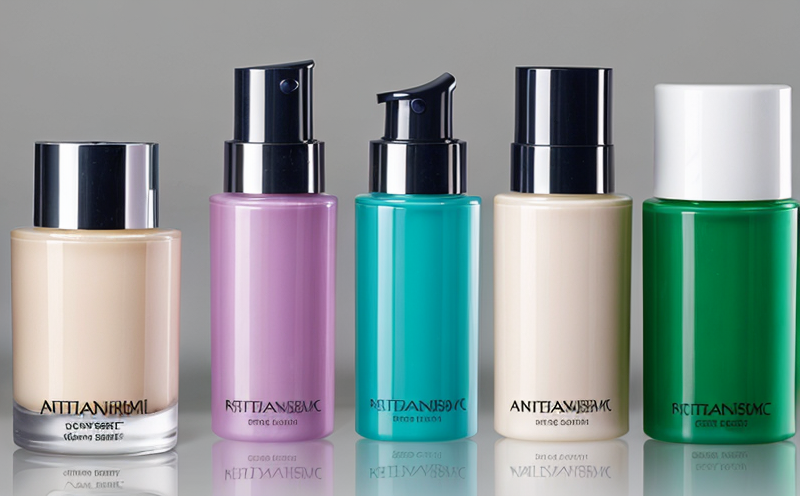Preservative Efficacy under Temperature Cycling in Cosmetics
The efficacy of preservatives is crucial to ensuring the stability and safety of cosmetic products. Preservatives prevent the growth of microorganisms such as bacteria, fungi, and yeast, which can spoil cosmetics over time or cause skin irritation. Temperature cycling tests are essential for evaluating how well preservatives function under varying environmental conditions that mimic real-world storage scenarios.
Temperature cycling simulates the fluctuating temperatures found in different parts of the world where the cosmetic products may be stored. This testing method is particularly important because it ensures that the product remains stable and safe to use even when exposed to extreme temperature changes such as those encountered during transit, storage, or use by consumers.
The test involves exposing the cosmetic product containing preservatives to a series of temperature cycles, usually between 4°C (39°F) and 55°C (131°F), which are designed to mimic conditions found in various climates. The sample is subjected to these extreme temperatures for specified durations, followed by holding periods at each temperature level.
During the test, it’s critical to monitor the growth of microorganisms such as Bacillus subtilis, Pseudomonas aeruginosa, and Candida albicans. These organisms are chosen because they represent a broad spectrum of potential contaminants that can affect cosmetic products. The test is conducted in accordance with international standards, including ISO 22196:2011, which specifies methods for evaluating antimicrobial efficacy.
The specimen preparation involves creating test samples containing the preservative to be evaluated and inoculating them with specific microorganisms. These samples are then subjected to temperature cycling according to predefined protocols that simulate real-world conditions. The testing process also includes assessing the appearance of the product, its consistency, and any signs of microbial growth.
The results from these tests provide valuable insights into the preservative's performance under fluctuating temperatures. This information is essential for ensuring the safety and efficacy of cosmetic products in a global market where temperature variations are common. The data generated can be used to optimize formulations, improve product stability, and enhance consumer trust by demonstrating that the product remains safe and effective under challenging conditions.
Understanding the nuances of preservative efficacy under temperature cycling is vital for quality managers and compliance officers who oversee product safety and regulatory adherence. R&D engineers benefit from this testing method as it informs their formulation decisions to ensure products meet stringent international standards like ISO 22196:2011. For procurement teams, this service ensures the best preservatives are sourced, enhancing overall product quality.
Applied Standards
| Standard Number | Title of Standard | Description |
|---|---|---|
| ISO 22196:2011 | Evaluation of antimicrobial efficacy on surfaces and in products | This international standard specifies methods for evaluating the efficacy of antimicrobials against a specified list of microorganisms. |
| ASTM G21-18 | Standard practice for determining resistance to atmospheric aging by exposure to natural weathering elements (open testing) | This American Society for Testing and Materials standard outlines the procedure for exposing materials to outdoor environmental conditions, including temperature fluctuations. |
| Test Condition | Description |
|---|---|
| Cycling Temperature Range | 4°C (39°F) to 55°C (131°F) |
| Holding Time | 12 hours at each temperature level |
| Number of Cycles | 7 cycles total |
International Acceptance and Recognition
The testing method for evaluating preservative efficacy under temperature cycling is widely accepted in the cosmetics industry. The ISO 22196:2011 standard, which specifies antimicrobial efficacy evaluation methods, has gained international recognition and is used by laboratories around the world to ensure product safety and compliance.
ASTM G21-18 provides a recognized framework for assessing material performance under outdoor weathering conditions. While it focuses on materials rather than cosmetics, its principles are applicable to evaluating cosmetic formulations' stability under varying environmental conditions. This standard is often referenced in conjunction with ISO 22196:2011 when conducting comprehensive temperature cycling tests.
The acceptance of these standards by regulatory bodies and industry leaders ensures that the results from such tests are credible and widely recognized. Compliance with these international standards enhances the reputation of cosmetics manufacturers, providing a competitive edge in both domestic and export markets.
Competitive Advantage and Market Impact
In today’s highly competitive market, ensuring product safety and efficacy is critical for maintaining consumer trust and loyalty. By offering comprehensive preservative efficacy testing under temperature cycling conditions, our laboratory provides a competitive advantage to clients in the cosmetics industry. This service helps manufacturers ensure their products remain stable and safe even when subjected to extreme environmental conditions.
Consumers are increasingly aware of the importance of product safety and expect companies to take stringent measures to protect them from potential risks. By demonstrating compliance with international standards like ISO 22196:2011, manufacturers can build a strong brand reputation and gain consumer confidence. This, in turn, leads to increased market share and customer loyalty.
For procurement teams, this service ensures that the best preservatives are sourced for their formulations, enhancing product quality and safety. The data generated from these tests also allows companies to optimize their formulations further, leading to improved product performance and enhanced consumer satisfaction.





